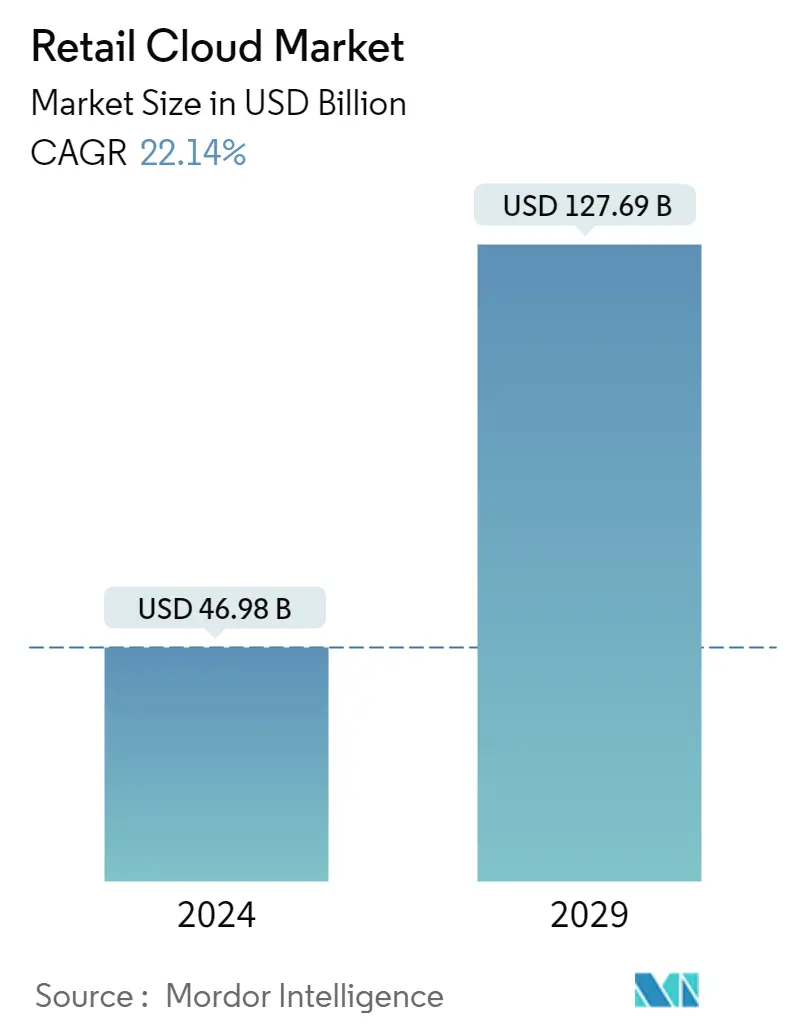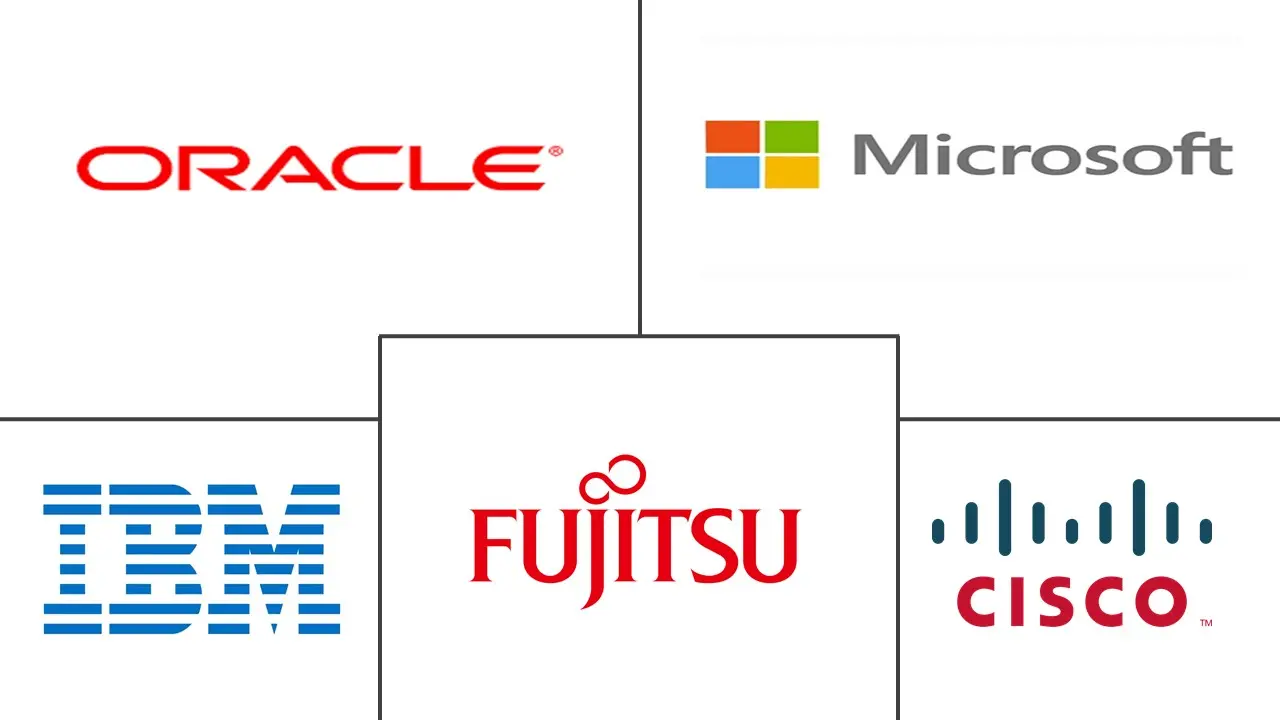Market Size of Retail Cloud Industry

| Study Period | 2019 - 2029 |
| Market Size (2024) | USD 46.98 Billion |
| Market Size (2029) | USD 127.69 Billion |
| CAGR (2024 - 2029) | 22.14 % |
| Fastest Growing Market | Asia Pacific |
| Largest Market | North America |
| Market Concentration | Medium |
Major Players
*Disclaimer: Major Players sorted in no particular order |
Retail Cloud Market Analysis
The Retail Cloud Market size is estimated at USD 46.98 billion in 2024, and is expected to reach USD 127.69 billion by 2029, growing at a CAGR of 22.14% during the forecast period (2024-2029).
The rise of e-commerce has set the standards for brick-and-mortar retail in recent years. Although shoppers complete most transactions in brick-and-mortar stores, customers have grown to expect the same personalized, relevant, convenient, and easy-to-use experiences they encounter online when they shop in-store, driving the retail cloud market significantly.
- To be successful today, retailers must optimize their businesses across all channels and continually meet and exceed consumer expectations. But most retailers with multiple channels in the current market still need help to provide a consistent experience across channels. As a result, consumers experience a different level of personalization than they do experience on online shopping sites. But in the case of a cloud solution or cloud platforms, it enables retailers to handle all problems that arise from implementing, maintaining, and interfacing disparate systems. This is where retailers are increasingly adopting digital solutions that are highly personalizing customer experiences. Thus, digital transformation amongst retailers is gaining traction, and retailers are emphasizing increasing their IT spending.
- Moreover, digital demographics in the retail industry are increasingly becoming essential to understand consumers. Moreover, with the rise in the adoption of omnichannel services, retailers worldwide are focusing extensively on offering customization, which will fuel the market's growth throughout the forecast period.
- Also, in terms of cloud deployment, a hybrid cloud is gaining traction amongst retailers owing to its benefits. In November last year, Computop introduced Cloud POS Interface for stores with multiple locations. The Cloud POS Interface would allow retailers to operate card terminals from any web-based ERP, store, or POS system through the Computop Paygate. Since it enables retailers to connect to POS terminals via the cloud, the system eliminates the overall need for the ZVT/OPI interface in the cash register to facilitate card payments. Another functionality of Cloud POS is enabling its terminals to be operated via a SIM card. If there's an instance when an airport is not connected to Cloud POS through a LAN or WiFi connection, retailers can utilize a SIM card to connect to the cashier system.
- However, the rise in vulnerability from cyber-attacks could be one of the most prominent reasons hindering the market's growth throughout the forecast period.
- The spread of Covid-19 has significantly impacted consumer behavior, product demand, and retail store, factory, and logistics services functioning. However, the impact on the retail cloud is uneven, depending on the market from various industries. For instance, low demand has hit the electronics and fashion industries hard. In contrast, food, household goods, and pharmaceuticals have seen a drastic shift in direction and thus are looking for Omni channel presence, further boosting the demand for retail cloud. The market is expected to prosper at a high rate during the forecast period due to its offered benefits compared to traditional retail.
Retail Cloud Industry Segmentation
Retail cloud arrangements enhance the shopping background with associated shopping crosswise over channels, adaptable returns, advanced administrations, customized connection over the supply chain, coordinated promoting, and steady understanding. The report covers a detailed analysis of solutions and service types provided by the vendors deployable over the public, private, and hybrid cloud. The report also covers a geographical analysis of the retail cloud market.
The Retail Cloud Market is Segmented by Solution (Supply Chain Management, Customer Management, Merchandizing, Workforce Management, Reporting and Analytics), Service Type (IaaS, SaaS, PaaS), Deployment (Public Cloud, Private Cloud, and Hybrid Cloud), and Geography (North America, Europe, Asia-pacific, Latin America, Middle East & Africa). The market sizes and forecasts are provided in terms of value (USD million) for all the above segments.
| By Solution | |
| Supply Chain Management | |
| Customer Management | |
| Merchandizing | |
| Workforce Management | |
| Reporting and Analytics | |
| Other Solutions |
| By Service Type | |
| IaaS | |
| SaaS | |
| PaaS |
| By Deployment | |
| Public Cloud | |
| Private Cloud | |
| Hybrid Cloud |
| By Geography | |
| North America | |
| Europe | |
| Asia Pacific | |
| Latin America | |
| Middle East and Africa |
Retail Cloud Market Size Summary
The retail cloud market is experiencing significant growth, driven by the increasing demand for personalized and seamless shopping experiences across both online and offline channels. As e-commerce sets higher standards, brick-and-mortar retailers are compelled to adopt cloud solutions to meet consumer expectations for convenience and personalization. This shift is further fueled by the need for digital transformation, with retailers investing more in IT to enhance customer experiences. The adoption of omnichannel services and hybrid cloud deployments is on the rise, enabling retailers to offer customized solutions and streamline operations. Despite challenges such as cyber vulnerabilities, the market is poised for substantial expansion, with Software as a Service (SaaS) leading the way due to its cost-effectiveness and scalability.
North America stands out as a leading region in the retail cloud market, driven by the presence of major retail chains and a high level of cloud solution adoption. The region's experimental retail environment and successful implementations, such as Bernhardt Furniture Company's use of IBM's retail cloud solutions, underscore the growing demand. The market is characterized by strategic mergers, acquisitions, and partnerships, with key players like HCL Technologies and Sonata Software enhancing their offerings through collaborations with Microsoft. Government initiatives and the adoption of advanced technologies like 5G further bolster market growth. The competitive landscape is marked by innovation and strategic developments, as companies like Wipro and Snowflake introduce new solutions to meet evolving retail demands.
Retail Cloud Market Size - Table of Contents
-
1. MARKET INSIGHTS
-
1.1 Market Overview
-
1.2 Industry Attractiveness - Porter's Five Forces Analysis
-
1.2.1 Bargaining Power of Suppliers
-
1.2.2 Bargaining Power of Buyers
-
1.2.3 Threat of New Entrants
-
1.2.4 Intensity of Competitive Rivalry
-
1.2.5 Threat of Substitutes
-
-
-
2. MARKET SEGMENTATION
-
2.1 By Solution
-
2.1.1 Supply Chain Management
-
2.1.2 Customer Management
-
2.1.3 Merchandizing
-
2.1.4 Workforce Management
-
2.1.5 Reporting and Analytics
-
2.1.6 Other Solutions
-
-
2.2 By Service Type
-
2.2.1 IaaS
-
2.2.2 SaaS
-
2.2.3 PaaS
-
-
2.3 By Deployment
-
2.3.1 Public Cloud
-
2.3.2 Private Cloud
-
2.3.3 Hybrid Cloud
-
-
2.4 By Geography
-
2.4.1 North America
-
2.4.2 Europe
-
2.4.3 Asia Pacific
-
2.4.4 Latin America
-
2.4.5 Middle East and Africa
-
-
Retail Cloud Market Size FAQs
How big is the Retail Cloud Market?
The Retail Cloud Market size is expected to reach USD 46.98 billion in 2024 and grow at a CAGR of 22.14% to reach USD 127.69 billion by 2029.
What is the current Retail Cloud Market size?
In 2024, the Retail Cloud Market size is expected to reach USD 46.98 billion.

